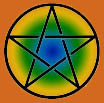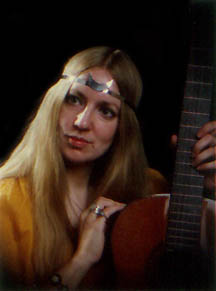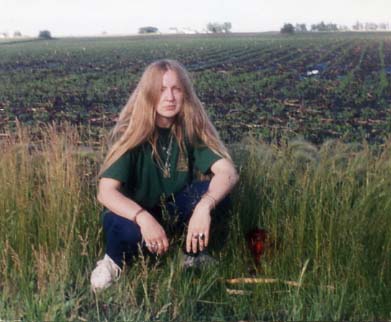 |
|
Ask Isadora (FAQ)
|
|
Isadora is a longtime clergywoman of the Craft with legal ministerial status, a trustee of the Universal Federation of Pagans, a member of ASCAP and the international Fellowship of Isis, and has been a biographee in The World Who’s Who of Women. Following an absence of several years from the Pagan music scene due to family commitments and other aspects of her life and career, Isadora plans to make it up to her bewitched, bothered, and bewildered fans by releasing a series of long-awaited new albums and gigging as often as possible at festivals and other gatherings and events. Lady Isadora is a genuine Renaissance woman of many hats. “My favorites are the Peter Pan and tall pointy black ones, along with my lunar crown and winged Valkyrie helmet,” she says. “But I’d adore one of those wildly chic, great big extravagantly-plumed numbers like the highwaymen and pirate captains of yore used to swagger about in, bless their brazen black hearts, the bedeviling blackguards! Literally to die for? No, thank’ee! I’ll stick with one of my signature long scarves, tied firmly ‘round my head, when scalliwag-channeling or in ‘Stand and deliver!’ mode – I’m far less likely to lose the thing during a frenzied midnight gallop ‘all on the Queen’s Highway,’ or deep, down, derry-down-down in the Old Briney, should the Powers – or perhaps a fearsome encounter with the infamous Captain Jack Sparrow? Yessss!!! – conspire to take me for a sudden swim. And so what if they do! Far out! Mermaids!” What perilous exploits next await our intrepid Isadora, if any? She purports to sing convincingly as both pirate queen and highwaywoman on her forthcoming album, Masquerade, at least. But sadly lacking anything remotely resembling a time machine, she has to settle for indeed merely masquerading as those ungentle worthies when the mood strikes – such as at Hallowe’en, her second-favorite Sabbat after Yule. Nevertheless, she's quite happy all year long to be a proud mother; fond witchcat-fancier; avid knitter cum hopelessly-addicted designer yarn junkie; devout tree-worshipper; cannily, cloak-and-daggeringly intrigue-inspired Nancy Druid-wannabe; free-expressive, ecstatic dancer; semi-gracefully aging flower child; Eric Burdon-adoring Animals-lover; diehard Beatlemaniac; forever fret-fandangoing Alvin Lee freak; fond White Stripes aficionada; and awe-inspired Yngwie Malmsteen devotee. Isadora is an avowed bibliophile, if that’s the appropriate word for someone whose tortuously tall TBR tower has long since attained super-skyscraper heights, and whose epitaph seriously threatens to become “So many books, so little t---.” Even so, Isadora continues her girlhood habit of reading in bed whenever possible, and holds out the prayerful hope that it will still be many years yet before she “finally” has to turn out the light and go to sleep, as it were. Or at least take some sort of refreshing catnap in between this and the next of her 9+ lifetimes. Isadora is a longtime writer and researcher in a number of diverse fields of interest. She has published articles in various Pagan, New Age, and mainstream journals, and is working on an unusual novel about Queen Elizabeth I, not to mention a very unusual series of girl detective novels. She is also compiling for publication a compendium of original rituals, poetry, and essays, entitled The Pen is a Magic Wand. Isadora is co-founder of the sorcerously subversive new social club network, the Black Witch-Hat Society. In the early 1970s, she was the one and only lonely founder of the only partly tongue-in-cheek Society for the Prevention of Witchcraft Being Called “Wicca”. (As she is all too fond of advising to whomever will listen, the original word was documentably “Wiccecraeft”, from the Old English/Anglo-Saxon – a Germanic, not Celtic tongue.) Of “mixed” British Isles and Scandinavian ancestry – the descendant of Saxon warriors; medieval English knights and land-owners; Welsh poets and schoolteachers; the Stewart, Macduff, and Fletcher clans of Scotland; a long line of high-minded British and American Freemasons; some very staunch American anti-slavery abolitionists; and an endearing assortment of stalwart Danish Vikings and stubborn Danish and Danish-American farmers – Isadora has been an avid enthusiast for her own ancestral languages and many others for most of her life. While at university, she was inducted into Delta Phi Alpha, the National German Honor Society, having won a number of academic awards in that language, including two from the German government. Isadora specializes in the studious pursuit of the Celtic and Germanic branches of the Indo-European language family tree. In honor of her adored favorite Sabbat, the annually happily-holly-crowned Isadora is readying an album of Yule carols with original and adapted lyrics, and both traditional and original melodies: Goddess Rest Ye Merry Gentlefolk. She has previously recorded a winter solstice suite entitled “Three Carols for Yule” on The Queen of Earth and Sky. Wrote Green Egg of her “achingly beautiful” song “Our Lady Greensleeves”: “Though many have written words for this primally moving melody, this telling of the Wheel Year in the crystalline voice of Isadora is the pinnacle of all.” Lady Isadora’s first album, The Witching Hour, was recorded in 1981 with her former partner, the formidably multi-talented Lord Pan. It was one of the first few Witch albums ever made. Following the 1990 dual release of Isadora’s 24-track studio solo albums, The Queen of Earth and Sky and Priestess of the Pentacle (on which she duets with then-7-year-old daughter Andred on one song), Isadora has continued to hold a devoted following and receive high praise from a number of Pagan luminaries and publications. Preceded by pioneering albums from the late, great Gwydion “We Won’t Wait Any Longer” Pendderwen, and from distinguished Mother of All Pagan Networking, Selena “Circle ’Round the Fire” Fox with then-partner Jim “Talking Wicca Blues” Alan, The Witching Hour shared their passionate devotion to unabashedly Witchy song themes, but differed in style and presentation. Isadora’s and Pan’s own distinctive bardic brew of folk, rock, medieval-Renaissance, and classical musical influences offered what many listeners felt to be an artier, more sophisticated, more dramatic sound, with strikingly poetic, often deeply mystical lyrics.
Initially sold through mail order ads in Pagan periodicals, The Witching Hour was soon picked up for distribution by Circle of Wisconsin, Magickal Childe of NYC, and other key founders of metaphysical networking and merchandising. It went on to expand its sales through such companies as White Light Pentacles, Abyss/AzureGreen, New Leaf, and Ladyslipper. It has been praised as a significant inspiration by a number of popular and talented Pagan musicians who recorded afterwards, including Todd Alan; Kenny & Tzipora; Ariana Lightningstorm of Kiva; Lady Siobhan; Angie Remedi; Michelle Mays, who in 2006 called Isadora “a Pagan National Treasure”; and SkyDragon of Lucidian, who in 2005 dubbed Isadora “the Queen of Musical Witches”. With its re-release on CD to a new generation of Pagan music fans, along with Isadora’s celebrated solo albums, the former duo’s expressive vocals, accomplished musicianship, and compelling songwriting and arranging talents are gaining an even wider audience. The Witching Hour was produced in only a few intensive sessions on mobile equipment, mostly in an apartment, which Isadora jokingly dubbed “Broom Closet Recording Studios.” It proved an ambitious project for those early days of Pagan recorded music, especially considering the budgetary and time constraints at hand. Many of the album’s 17 original selections required a number of vocal and multi-instrumental overdubs, a technique not commonplace in Pagan albums for several years to come. “Pan and I had time booked with an acquaintance who was starting up his own grass-roots recording outfit with a portable multi-track Tascam unit," Isadora recalls. "Far fewer people in those days were recording their own albums or founding their own independent labels, so I was pretty jazzed, dreaming of what we could try to accomplish in our own home with that sort of equipment. As it happened, Pan had a commitment to drive a friend’s car halfway across the country in a few days. So we came, we tuned, we blitzed. And despite the limitations we faced, not least of which was the fact that our engineer was a relative novice technically, something really magical happened. I remember we finished up under the Full Moon in Aquarius, and I felt especially harmonious with that – Aquarius is my sun sign. But even more, I was struck by the feeling that we were truly conjuring up a unique magical entity with our new album. I felt the Goddess and the God, as they were and are within us and without us, expressing themselves through us as we played and sang. “Of course, on the feet-of-clay side, producing an album under a near deadline on a shoestring isn’t much different from releasing a live album – here and there are little things you end up leaving in if you can’t go back and do a take three or a take thirteen, or whatever. Some of Pan’s fabulous folk-rock extravaganza tracks with several instruments going at once deserve a remix for greater clarity some day, if the original unmixed Tascam tape ever resurfaces. Hmmm... hocus-pocus-abracadocus! [Laughs] Even so, I’d say his masterpiece 'Realm of Faerie', with its ringing electric 12-string, gorgeous melody, poignant lyrics, and soulful vocals, is worth the price of the album alone. It’s brilliant! "Considering the very grass-roots sound quality of some other early Pagan albums – though they did the best they could with what they had, as did we – The Witching Hour still sounds pretty good, I think. According to the fan mail I still get about it, there’s a definite mystique there that apparently overrides occasional technical flaws. I sometimes feel some retrospective perfectionistic frustration about those, but nobody ever mentions them, if they notice or care – I think because the album made such a strong statement for the Craft musically and artistically, even politically. I have to say I’m proud of our work on it. After its release, I received a flurry of letters from folks near, far, and wide, who enthused that the album filled a real need for them as Witches and music lovers. I was thrilled! I still am.” Over the last quarter of a century, The Witching Hour has been hailed as a historic contribution to Witch & Pagan recorded music – a beloved favorite of many in the magical community. Wrote Phoenix NightSong of NC about Isadora: “...this gorgeous haunting voice to rival Sarah Brightman, guitar prowess to rival Lita Ford, and a songwriting gift to rival Lennon-McCartney.” From K. Vaughan of CA: “Lady Isadora’s voice is a gift of the Goddess.” From L. Brustad of ND: “...truly the finest Pagan music I have ever heard.” From H. Nolen of NE: “You’re AWESOME! Thank you thank you thank you for YEARS of enjoyment of your music! You ROCK, sister!” From C. Sheehan of FL: “Divine Genius... phenomenal...” And from F. James of CA: “I’d like to say something nice about her music and her voice, but there are no words, at least not in the English language.” Though Isadora has earned such review accolades as “a voice that rivals Judy Collins’”, “guitar prowess to rival Lita Ford”, and “the Joni Mitchell of the [Witchcraft] movement”, she declines to style herself with such titles. “Of course, I’m very flattered to have been given so much praise, ” she admits. “If somebody says it or writes it, I’ll have it put on my reviews webpage, with great appreciation. If all the promo quotes sell somebody on checking out my music, so be it, and I hope they enjoy my songs. Like any other musician, I want to be able to make a living from my work. Like all musicians, I have my influences. But I don’t want to get stuck on them. I’ve always felt it’s the individual voice one represents, and what one brings to music that’s new and unique, that are truly important. I don’t want to play the Jonier-than-thou game certain young female singer-songwriters today seem rather caught up in. Yes, Joni Mitchell and other great mainstream recording artists have been pioneering musical sisterspirits for many of us. Listening to their work in our younger years helped awaken the chords of our own beings – and those are the chords we really should be playing, when all is said and sung. I put my own Witchy and very personal stamp on my influences, I feel, and took them in new directions. I’ve continued to grow and deepen as a songwriter, so I’m eager to share my previously-unreleased and more recent material with fans, as well. Yes, Joni et al are fabulous, without doubt, but so are we. We’ve got our own voices to raise and our own songs to sing. So... I really don’t see myself as Judy Collins in a tall black pointy, or empress of ethereal sopranos, or the bitchin’est, bewitchin’est broomstick babe of bards, or whatever. [Laughs and winks.] I suppose it might be cool to be considered the next Billie Holiday, or the next Hildegard von Bingen – or maybe a quirkily groundbreaking new combination of the two [laughs again] – but I’d really rather be the one and only Lady Dizzy Aura, anyway. If I happen to be somebody’s favorite musician, then sure, I’m happy, but I do keep it in perspective. Music is an art, not a contest!” A devout Arthurian (and Gueneverean!), Isadora was the longtime high priestess of the erstwhile Des Moines, Iowa-based Coven of the Pendragon, which she is planning to resurrect in more far-reaching form as a network and e-group. Isadora has made the Matter of Britain a recurring theme in several of her songs, including the above-quoted “Table Round,” “After the Death of Arthur” on The Witching Hour, and “Lion-Hearted Woman” as well as the title song on The Queen of Earth and Sky. She has had a lifelong fascination with the Robin Hood legend as well, as reflected in her haunting a capella track on Priestess of the Pentacle, “Maid Marian’s Lament.” Isadora has entirely lost count of how many times she has seen Errol Flynn’s classic 1938 movie, The Adventures of Robin Hood. Perhaps if she watches it one more time, that will jog her memory? Isadora and her daughter Andred are co-priestesses of a family-based coven, Tree of Thirteen Runes, in Des Moines and at points beyond. Isadora’s primary focus for many years has been on the British Isles and Old Norse deities and mysteries of her ancestry. She is a devotee of Gwenhwyfar the Golden-Haired and the fabulous freewheeling Freyja, and has a particular affinity for sun goddesses. Isadora is a student of Native American spiritual ways as “Corn Tassel,” a name taken for her blond hair and Iowa heritage in “the Corn State.” (She is, however, every bit as proud of being a devout Lady Liberty-worshipping half-New Yorker). Isadora’s longtime Witch name is Greek for “Gift of Isis” – an epithet she finds much more challenging to live up to, “by Holy Hera’s High Heels!,” to use Isadora’s favorite original oath. One of her nicknames has long been “Dizzy Aura.” Nevertheless, from the more broadly eclectic priestessing of her younger years, Isadora still retains a special devotion to mighty Isis, iridescent Iris, stalwart Athena, wise Hecate, sacredly symbiotic Demeter and Persephone, and sublimely compassionate Mother Mary, among others. In any case, it is Peter Pan, that blithe and bonny Junior Green Man, who has been the ultimate god of Isadora’s idolatry since childhood, during which time, as one of her song lyrics affirms, she also “read every Little Witch Girl book [she] could find in the library.”
Groups & Affiliations • Ask Isadora (Frequently Asked Questions) Musings, Meanderings, & Miscellaneous Madcap Mayhem Lost in the Lady's Labyrinthine Lair? Visit the Site Map!
|
||||||||||

 An experienced Witch priestess and ritual artist, Lady Isadora is also a critically-acclaimed singer-songwriter, guitarist, arranger, and producer. She was one of the early founders of the Witch & Pagan musical genre. All three of her classic recordings, The Queen of Earth and Sky, Priestess of the Pentacle, and The Witching Hour, are now available
An experienced Witch priestess and ritual artist, Lady Isadora is also a critically-acclaimed singer-songwriter, guitarist, arranger, and producer. She was one of the early founders of the Witch & Pagan musical genre. All three of her classic recordings, The Queen of Earth and Sky, Priestess of the Pentacle, and The Witching Hour, are now available 


